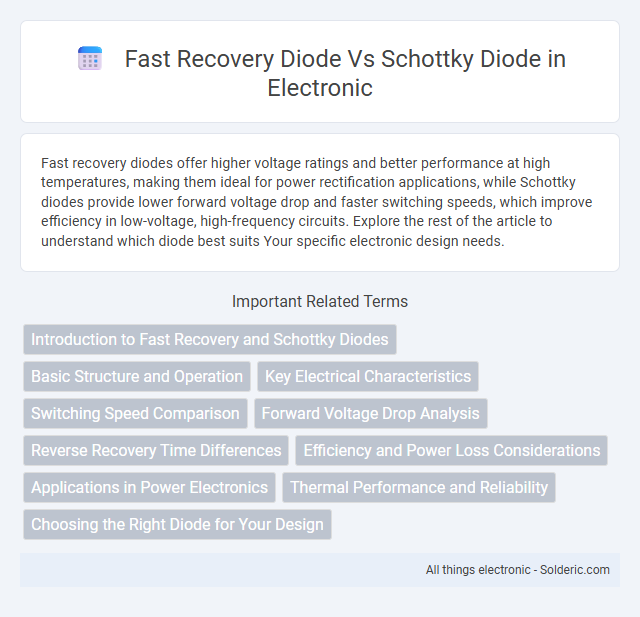Fast recovery diodes offer higher voltage ratings and better performance at high temperatures, making them ideal for power rectification applications, while Schottky diodes provide lower forward voltage drop and faster switching speeds, which improve efficiency in low-voltage, high-frequency circuits. Explore the rest of the article to understand which diode best suits Your specific electronic design needs.
Comparison Table
| Feature | Fast Recovery Diode | Schottky Diode |
|---|---|---|
| Recovery Time | Fast (typically 50-500 ns) | Ultra-fast (few nanoseconds) |
| Forward Voltage Drop | Approximately 0.7 - 1.0 V | Low, typically 0.2 - 0.4 V |
| Reverse Recovery Charge | Moderate | Minimal to none |
| Leakage Current | Low | Higher compared to fast recovery diodes |
| Junction Type | PN Junction | Metal-Semiconductor Junction |
| Applications | Switching power supplies, inverters | Power rectifiers, RF applications, low voltage power circuits |
| Maximum Reverse Voltage | Higher rating, up to several hundred volts | Typically lower, often below 100 V |
| Power Dissipation | Higher due to higher forward voltage drop | Lower, improving efficiency |
Introduction to Fast Recovery and Schottky Diodes
Fast recovery diodes are designed to quickly switch from conducting to non-conducting states, minimizing reverse recovery time and reducing switching losses in high-frequency power applications. Schottky diodes feature a metal-semiconductor junction, offering low forward voltage drop and extremely fast switching speeds, which enhances efficiency in low voltage, high-speed circuits. Both diode types improve performance in power electronics, with fast recovery diodes favored for high voltage rectification and Schottky diodes ideal for low voltage, high-frequency switching.
Basic Structure and Operation
Fast recovery diodes feature a p-n junction with a specifically designed lightly doped region to minimize reverse recovery time, enabling rapid transition from conducting to blocking state. Schottky diodes consist of a metal-semiconductor junction, typically metal to n-type semiconductor, which allows majority carrier conduction with very low forward voltage drop and negligible reverse recovery time. The fundamental difference in structure results in fast recovery diodes having stored charge in the depletion region, while Schottky diodes operate without minority carrier charge storage, leading to their ultra-fast switching capabilities.
Key Electrical Characteristics
Fast recovery diodes feature a reverse recovery time typically in the range of tens to hundreds of nanoseconds, making them suitable for high-speed switching applications. Schottky diodes offer lower forward voltage drops (around 0.2 to 0.4 volts) and near-zero reverse recovery time, resulting in higher efficiency and reduced switching losses. Your choice depends on the specific requirements for switching speed, voltage drop, and efficiency in power electronics circuits.
Switching Speed Comparison
Fast recovery diodes possess moderate switching speeds with recovery times typically ranging from 50 to 500 nanoseconds, making them suitable for applications requiring efficient switching but less stringent speed demands. Schottky diodes offer significantly faster switching speeds, often in the range of a few nanoseconds due to their majority carrier conduction mechanism, resulting in minimal charge storage and reduced reverse recovery time. This characteristic makes Schottky diodes ideal for high-frequency and high-efficiency circuits where rapid switching is critical.
Forward Voltage Drop Analysis
Fast recovery diodes typically exhibit a higher forward voltage drop, around 0.7 to 1.1 volts, compared to Schottky diodes, which have a lower forward voltage drop ranging from 0.15 to 0.45 volts. This lower forward voltage drop in Schottky diodes results in reduced conduction losses and improved efficiency in power conversion applications. The choice between these diodes significantly impacts thermal management and overall circuit performance, especially in high-frequency switching applications.
Reverse Recovery Time Differences
Fast recovery diodes feature a longer reverse recovery time compared to Schottky diodes, which typically have negligible or near-zero reverse recovery time due to their metal-semiconductor junction. The reduced reverse recovery time in Schottky diodes minimizes switching losses and electromagnetic interference, making them ideal for high-frequency applications. Your circuit efficiency and switching speed improve significantly when choosing Schottky diodes over fast recovery diodes in designs requiring rapid switching transitions.
Efficiency and Power Loss Considerations
Fast recovery diodes exhibit higher reverse recovery times compared to Schottky diodes, leading to increased switching losses and reduced efficiency in high-frequency applications. Schottky diodes feature low forward voltage drops (typically 0.2 to 0.4 V) and minimal reverse recovery charge, resulting in lower conduction and switching losses, which enhances overall power efficiency. Consequently, Schottky diodes are preferred in power-sensitive circuits demanding high efficiency and minimal power dissipation.
Applications in Power Electronics
Fast recovery diodes are widely used in power electronics applications requiring fast switching and low reverse recovery time, such as in inverter circuits, motor drives, and rectifiers for high voltage and high current environments. Schottky diodes excel in low voltage applications with their ultra-low forward voltage drop and minimal switching losses, making them ideal for power supply rectification, voltage clamping, and RF applications. Both diodes enhance efficiency and performance in power electronics, with fast recovery diodes preferred for handling high inductive loads and Schottky diodes favored for high-frequency, low voltage circuits.
Thermal Performance and Reliability
Fast recovery diodes exhibit superior thermal performance due to their ability to handle higher junction temperatures, making them suitable for applications with significant thermal stress. Schottky diodes, while offering low forward voltage drop and fast switching speeds, generally have lower maximum junction temperatures and can be less reliable in high-temperature environments. Your choice between these diodes should consider the thermal conditions and long-term reliability requirements of your specific application.
Choosing the Right Diode for Your Design
Fast recovery diodes excel in applications requiring high voltage and temperature tolerance with moderate switching speeds, making them ideal for power rectification in inductive loads. Schottky diodes offer lower forward voltage drop and faster switching times, perfect for minimizing power loss in low-voltage, high-frequency circuits such as power supplies and RF applications. Understanding your design's voltage, current, and switching frequency requirements will help you select the diode that maximizes efficiency and reliability.
Fast recovery diode vs Schottky diode Infographic

 solderic.com
solderic.com